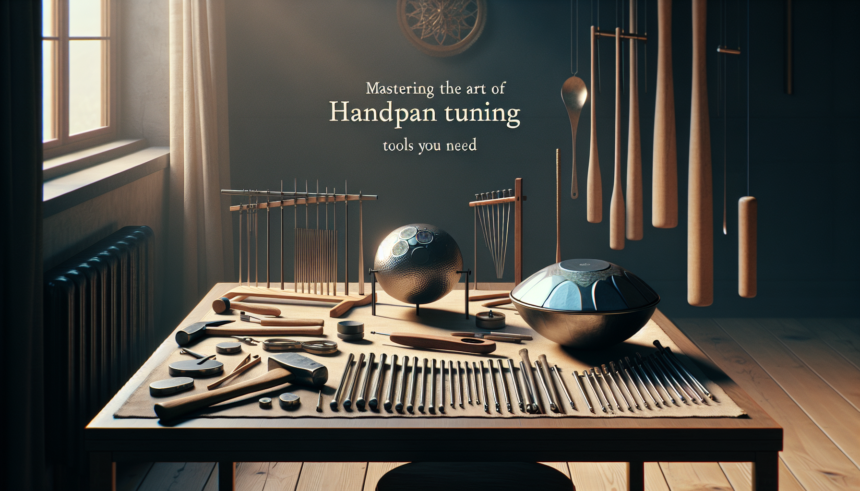Handpans, with their mesmerizing, ethereal soundscapes, have captured the attention of musicians and enthusiasts around the world. However, the true beauty of these instruments lies in their precise tuning. Mastering the art of handpan tuning requires not only a keen ear but also the right set of tools. This article dives into the essential tools required for handpan tuning and offers insights on perfecting your craft.
The Importance of Proper Tuning
Handpans are unique in that each note on the instrument is intricately connected. A single note out of tune can disrupt the harmonic balance, affecting the overall sound. Proper tuning ensures that each note resonates beautifully, creating the angelic tones that handpans are known for. Therefore, investing in the right tools and learning the correct techniques is crucial for any handpan tuner.
Essential Tools for Handpan Tuning
1. Tuning Hammer
The tuning hammer is a fundamental tool in the handpan tuning process. It is used to adjust the pitch of the notes by striking specific areas of the instrument. Tuning hammers come in various shapes and sizes, each designed for different tasks. A good tuning hammer has a comfortable grip and allows for precise control, enabling the tuner to make minute adjustments accurately.
2. Electronic Tuner
An electronic tuner is indispensable for both novice and experienced tuners. This device helps identify the exact frequency of each note, ensuring that they match the desired pitch. There are various types of electronic tuners available, from simple clip-on models to advanced software applications. The key is to choose one that is sensitive and accurate enough for handpan tuning.
3. Stethoscope
While it might seem unusual, a stethoscope is a valuable tool for handpan tuners. It allows you to listen to the vibrations and overtones of the instrument more closely. This can be particularly useful when fine-tuning notes or when you need to focus on a specific area of the handpan without external noise interference.
4. Rubber Mallets
Rubber mallets are used to adjust the shape of the notes on the handpan without causing damage to the metal. These mallets are available in different hardness levels, allowing the tuner to select one that matches the specific requirements of the note being adjusted. They provide the necessary force without risking the structural integrity of the instrument.
5. Shaping Tools
Shaping tools, such as anvils and mandrels, are essential for maintaining the correct shape of the handpan’s notes. Anvils provide a solid base, while mandrels help in forming the precise curves required for each note’s optimal resonance. These tools ensure that the notes are not only in tune but also have the correct shape for the best sound quality.
6. Microphone and Audio Interface
Using a high-quality microphone and audio interface can greatly enhance the tuning process. Recording the notes and analyzing their frequencies using software can provide a clearer picture of any discrepancies. This setup allows tuners to make more informed adjustments and ensure the highest quality sound.
Step-by-Step Handpan Tuning Process
Mastering handpan tuning involves a meticulous, step-by-step process. Here is an overview:
Step 1: Initial Assessment
Before making any adjustments, thoroughly evaluate the current state of the handpan. Play each note and listen for any discrepancies or out-of-tune sounds.
Step 2: Use the Electronic Tuner
Utilize the electronic tuner to measure the frequency of each note. Compare these frequencies with the desired pitches and identify which notes need adjustment.
Step 3: Adjust with Tuning Hammer and Rubber Mallets
Using the tuning hammer and rubber mallets, gently tap the necessary areas to raise or lower the pitch. Small, controlled taps are crucial to avoid over-adjusting.
Step 4: Close Listening with a Stethoscope
For fine adjustments, use the stethoscope to listen to the overtones and exact tuning of each note. This helps in making more precise changes.
Step 5: Shape the Notes
Employ shaping tools to adjust the shape of the handpan’s notes, ensuring they are optimized for the best sound quality. This step might involve using anvils and mandrels to refine the curvature of each note area.
Step 6: Recording and Analyzing
Record the handpan’s sound using a microphone and audio interface. Analyze the recording to identify any remaining tuning issues. This step is particularly useful for final adjustments.
Step 7: Reassessment
After making adjustments, reassess the entire handpan. Play each note again and use the electronic tuner and stethoscope to ensure that all notes are perfectly in tune.
Conclusion
Mastering the art of handpan tuning is a blend of science and artistry. It requires a combination of precise tools, keen listening, and an understanding of the instrument’s unique properties. By investing in essential tools such as tuning hammers, electronic tuners, rubber mallets, and more, you can ensure that your handpan produces the mesmerizing, harmonious sounds that have captivated audiences worldwide.
Through practice and dedication, you can refine your tuning skills and bring out the best in your handpan, achieving a sound that is both enchanting and precise.
FAQs
1. What is the most challenging aspect of handpan tuning?
The most challenging aspect of handpan tuning is achieving the perfect balance of overtones and ensuring that all notes are harmoniously in tune. This requires not only precise tools but also a keen ear and experience in understanding the unique sound properties of handpans.
2. How often should a handpan be retuned?
The frequency of retuning a handpan depends on various factors, including how often it is played and the environment in which it is stored. Generally, a well-maintained handpan might only need retuning every few years, but if it is played frequently or subjected to extreme conditions, it may require more regular adjustments.
3. Can I tune my handpan without any experience?
Tuning a handpan without prior experience can be quite challenging and potentially risky for the instrument. It is recommended to start by learning from experienced tuners or taking courses to understand the fundamentals. Improper tuning can damage the handpan, leading to costly repairs or replacements.
4. Are there any online resources available for learning handpan tuning?
Yes, there are various online resources available, including video tutorials, forums, and instructional websites dedicated to handpan tuning. These resources can provide valuable insights and step-by-step guidance for those looking to master the art of handpan tuning.
5. What is the difference between a tuning hammer and a rubber mallet in handpan tuning?
A tuning hammer is specifically designed for making precise pitch adjustments by lightly tapping areas of the handpan. In contrast, rubber mallets are used to shape the notes without causing damage to the metal. Both tools are essential but serve different functions in the tuning and shaping process.





